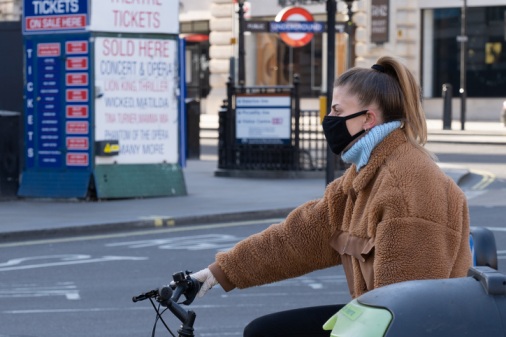Road safety in the new era of cycling and walking

Authored by QBE Senior Risk Manager James Billings
A desire for exercise during the Covid-19 pandemic, concerns over social distancing on public transport, and Government encouragement, has led to the UK enjoying a boom in cycling and walking.
In May, the Government announced a £2 billion package to help stimulate a ‘new era’ for cycling and walking.
The measures are to include ‘pop-up bike lanes’ with protected areas for cyclists, wider pavements for pedestrians and support for a number of local authority schemes to help make it easier for people to use bikes to get around, including Greater Manchester’s proposal to create 150 miles of protected cycle track.
As a result, bike shops have seen increased sales and some stocks running low. With retailers reporting unprecedented demand for bikes, the Government responded by announcing its ‘Fix your Bike Voucher Scheme’, whereby people in England could access a £50 voucher towards the cost of having an old bike made safe for the road. The voucher scheme has proved popular and all vouchers in the first batch have now been allocated.
E-scooter trials
To further help reduce the burden on public transport, the Department for Transport has brought forward its trials of rental e-scooters, to gather evidence on the benefits, their safety, and to then determine if they should be fully legalised and what rules should apply.
The first trials, involving 100 electric scooters, are taking place in the Tees Valley Combined Authority area, across Middlesbrough and surrounding areas. Trials are due to last for 12 months.
The trial e-scooters can travel at up to 15.5 miles per hour. They will be able to be used on roads and cycle lanes, but not on motorways or pavements. Riders will need to hold a full or provisional UK driving licence and it is recommended that they wear a helmet. Motor insurance is required, to be provided by the rental operator.
Increased risk to vulnerable road users
With so many more people getting around on bikes or on foot (or e-scooter), there are concerns for increased risk to vulnerable road users, for example:
Pedestrians
• Children running out into the road without looking
• ‘Distracted walkers’ texting or talking on their mobile phones whilst walking
• People with decreased mobility or difficulties in seeing or hearing approaching traffic
Cyclists and motorcyclists
• Can be difficult to see, especially at junctions and roundabouts and turning right into a road
• Can be affected by side winds, causing them to sway or wobble
• Children on bikes may ride out into the road
Drivers of a certain age may remember the classic TV advert from the 1970s - “Think once. Think twice. Think bike.” It’s still good advice today.
What are the risks?
Latest published figures for Great Britain show pedestrians accounted for 26% of road deaths, motorcyclists 20% and cyclists 6%.
In the 2019 National Travel Attitudes Survey, 61% of adults in England said that they felt that it is ‘too dangerous’ to cycle on the road. Around 80% of cycling accidents happen in daylight, mostly in urban areas and especially around T-junctions and traffic islands.Rush hour is the most dangerous time for non-fatal incidents, whilst most fatal accidents occur in the dark, and half of them on rural roads.
Professional drivers and fleet operators will be familiar with the risks caused by ‘blind spots.’ These are the areas around the vehicle that a driver cannot see by looking through the windows or standard mirrors. Blind spots affect many vehicle types but are especially worrying on larger vehicles such as buses, coaches and trucks. The result could be a driver not seeing a cyclist pedalling up the inside of the vehicle.
Speed is also a factor. Drivers travelling at higher speeds will have less time to react, and the higher the speed, the more serious the accident can be.
• If a vehicle hits a pedestrian at 30 miles per hour there's a 1 in 5 chance that they will die
• If a vehicle hits a pedestrian at 40 miles per hour there’s a 90% chance of their death
What can drivers and fleet operators do?
All drivers should exercise basic safety routines, including:
• When parking, check your mirror before opening the door
• When turning left let a cyclist in front pass the junction first
• When turning right move over completely to the far right of the lane
• Leave as much room as possible when passing cyclists
• Don’t overtake if the road is narrowing
• Judge cyclists’ speed carefully as they may be going faster than you think
• At traffic lights avoid driving into the ‘advanced stop area’ for cyclists
• If possible, don’t drive in cycle lanes and never park in them
• On rural roads make sure you can stop well within the distance you can see ahead
• On wet roads give cyclists extra space, as slick road tyres can slip
Commercial fleet operators can also:
• Consider the NCAP safety ratings when buying fleet vehicles, including pedestrian protection
• If not already, investigate technology to reduce blind spot risks, such as blind spot detection, proximity sensors, wide-angle mirrors and reversing alarms
• Fit underrun guards to prevent people and objects being dragged under the vehicle
• Consider the use of speed-limiting systems on fleet vehicles
• Address any potential driver distractions, such as use of mobile phones at the wheel
• Use driver training programmes, staff briefings and fleet safety forums to raise awareness of safety issues
• Monitor driver speed and behaviour by using telematics systems and other safety apps
Increased vigilance, increasing space for cyclists and decreasing your speed around them, will help to cut the risk for vulnerable road users.
About QBE
QBE European Operations is part of QBE Insurance Group, one of the world’s leading international insurers and reinsurers and Standard & Poor’s A+ rated. Listed on the Australian Securities Exchange, QBE’s gross written premium for the year ended 31 December 2018 was US$13.7 billion.
As a business insurance specialist, QBE European Operations offers a range of insurance products from the standard suite of property, casualty and motor to the specialist financial lines, marine and energy. All are tailored to the individual needs of our small, medium and large client base.
We understand the crucial role that effective risk management plays in all organisations and work hard to understand our clients’ businesses so that we offer insurance solutions that meet their needs – from complex programmes to simpler e-trading solutions – and support them in minimising their risk exposures. Our expert risk management and rehabilitation practitioners focus on helping clients improve their risk management so that they may benefit from a reduction in claims frequency and costs.

